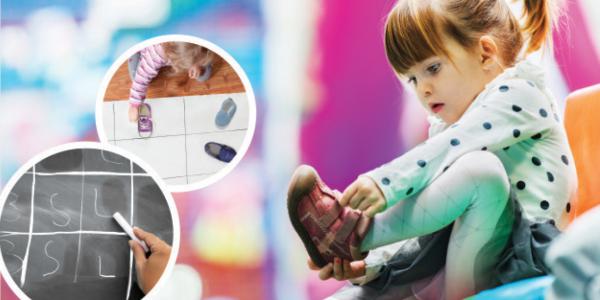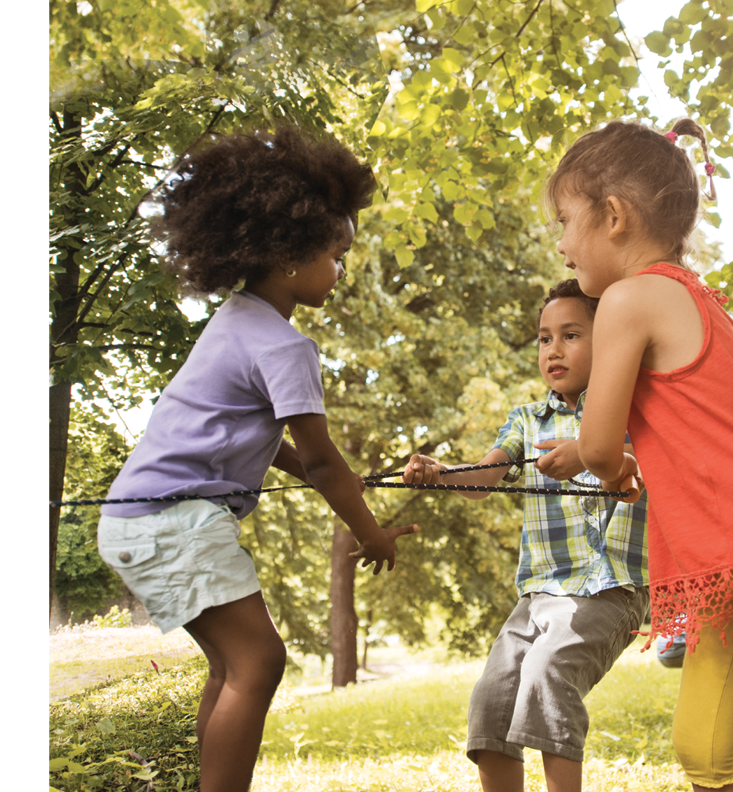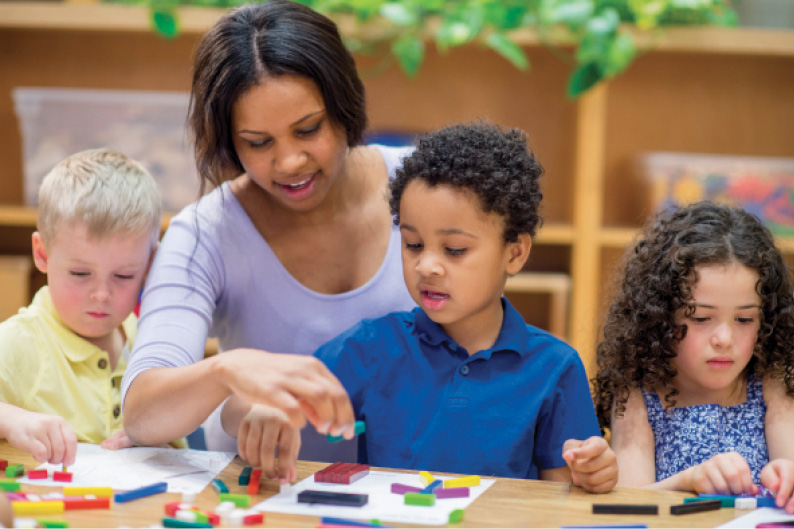Playful Math Instruction in the Context of Standards and Accountability

You are here
The children in Marylou’s preschool class are wearing only one shoe when I walk in the door. I am confused. I expected to see a math lesson, and instead I see children throwing their shoes into a pile. I soon understand that this is a math activity.
Marylou has drawn a 6 x 10 grid on a shower curtain spread on the floor. She asks the children to sort the shoes into six piles, according to certain attributes they have agreed on—sandals, slip-ons, shoes with laces, etc. Then, in the bottom row of the grid, they place one shoe from each pile in its own square, followed by the rest of the shoes from that pile, one each in the squares above the first shoe. After the children count the number of shoes category with a letter (L for laces, etc.). Under each column they write the total number of shoes in that category and continue the discussion: What kind of shoes did most children wear to school today? How many more Velcro shoes would they need for the Velcro column to be the same height as the slip-on column?
For the children, this activity was a game.
For Marylou, it was serious business. In this one lesson she had the children engaged in multiple components of the math curriculum—categorization, basic number skills (counting, one-to-one correspondence, cardinality, writing numbers), graphing, and measurement.
In another preschool I visited, children explored the defining qualities of shapes. On the playground, three children stood in equally spaced positions, with a rope pulled taut around them, forming an equilateral triangle. The teacher, Juan, asked them what shape they made and how many angles and sides there were. He then asked one of the children to move, keeping the rope taut, and repeated the questions. Juan also had children stand with a taut rope in groups of four, moving to create a rectangle with two long sides and two short sides, then moving to create four equal sides. He asked a series of questions—How many angles does the shape have, how many sides? What is a rectangle with equal sides called? What do all rectangles have in common?
Some of the children who were not participating directly in the shape climbed up a play structure to see the shapes from above, and they eagerly called out answers to Juan’s questions.
In other classrooms, I have observed children enthusiastically count collections of erasers, small toy animals, colored cotton balls, and buttons, then represent their counts on paper—often by drawing the objects or a circle to represent each item and placing the objects on their representations to ensure an accurate count. I have watched young children play the card game War, counting the symbols (hearts, spades, clubs, diamonds) on each number card played to determine whose card has more. (Teachers can make the game more complex by having each child play two cards, add them, and then compare the sum with the other child’s sum.) I have seen children hunt shapes in their classroom, debating whether a window with slightly curved corners is really a rectangle. I’ve witnessed a teacher read a picture book and ask children to find objects in front of, on top of, next to, and behind a house, and to identify the biggest and the smallest dogs in the illustrations.
Play versus academic skills: It’s not a zero-sum game
Did the children engaged in these activities know they were participating in math lessons? Probably not. But they were indeed learning math through what I refer to as playful instruction.
 All of these activities were intentional on the part of the teacher, who had particular math learning goals in mind. All were carefully planned. Some had the added value of allowing children to move around, making the activity more engaging for those who find it difficult to sit in one place. And in all of these activities, the teacher had an opportunity to assess children’s understanding through observation and by inviting particular children to contribute to the conversation.
All of these activities were intentional on the part of the teacher, who had particular math learning goals in mind. All were carefully planned. Some had the added value of allowing children to move around, making the activity more engaging for those who find it difficult to sit in one place. And in all of these activities, the teacher had an opportunity to assess children’s understanding through observation and by inviting particular children to contribute to the conversation.
There is no need to choose between play and teaching academic knowledge and skills.
This may not look like standards-based academic teaching, but it is. Many teachers of young children are understandably anxious about current standards and accountability pressures that have been pushed down to preschool. Many have shared with me concerns about how these pressures can interfere with what young children really need—daily opportunities to learn through play. Some teachers are also worried that teaching academic skills at an early age may undermine children’s natural curiosity and motivation. But these examples of playful math instruction make it clear that there is no need to choose between play and teaching academic knowledge and skills. Abundant research has demonstrated that young children enjoy learning math and can learn far more than was previously assumed—without a single flash card or worksheet (National Research Council 2001; Clements & Sarama 2014; Carpenter et al. 2016).
Playful math has an added bonus: social skills development can easily be integrated into teacher-planned math activities. Research has shown that some types of board games (e.g., linear path games with lots of counting, like Chutes and Ladders) promote children’s math abilities (Siegler & Ramani 2009). They also give children practice following rules, taking turns, and winning and losing gracefully. Similarly, Marylou’s shoe categorization activity requires children to discuss and agree on categories and raise their hands to answer questions, and it allows everyone to participate. Juan’s shape activity requires children to negotiate who moves where in response to teacher directions and to pay attention to others collaborating on the shape. Children are not learning math instead of social skills; they are learning math and social skills.
Teacher-initiated versus child-initiated math activities
Why are intentional, planned activities necessary? Don’t teachers need to weave academic learning into activities initiated by children to make them child centered? For example, couldn’t a teacher take advantage of children building a fort with blocks to help them learn about relative size? Couldn’t she spontaneously offer a counting and comparison lesson to a group of children arguing about how many toy farm animals they each receive?
Yes, teachers can and should seize on naturally occurring learning opportunities. But they can’t rely entirely on spontaneous, child-initiated teachable moments. It would leave the order in which math concepts are introduced—or even whether they are introduced—too much to chance. Moreover, if teachers depend solely on child initiative, children’s opportunities to learn will vary widely; some will have many opportunities, while others might have few. In addition, if teachers do not plan small group and whole group activities that provide systematic information about children’s knowledge and skills, they will have difficulty keeping track of what children understand and what support they need to grow and learn.
Math standards do not preclude teachers implementing playful, engaging activities. And they can help teachers determine the content and order of the activities they develop. While accountability can be beneficial or problematic, depending on how it is implemented, math standards are still useful. They have been carefully crafted and vetted by diverse groups of content area experts and educators so teachers don’t have to figure out everything on their own.
Making standards, accountability, and packaged curricula work
Standards can be intimidating, but they have value. The math standards developed in states, districts, and other organizations, such as Head Start, serve as a destination deemed desirable by experts. If  teachers don’t know where they want to end up, they will have a hard time figuring out how to get there.
teachers don’t know where they want to end up, they will have a hard time figuring out how to get there.
Still, standards should guide, not dictate, instruction. I have observed some teachers who, anxious about meeting standards or following a standards-based curriculum, teach concepts that are too advanced for some children. When this happens, the children quickly become restless and frustrated—or just refuse to participate.
If teachers depend solely on child initiative, children’s opportunities to learn will vary widely.
Standards can also lead to underestimating what some children are ready to learn. A recent study of a nationally representative sample of kindergartners found that before they entered kindergarten, children had already mastered most of the mathematics skills kindergarten teachers reported teaching (Engel et al. 2016). For example, although the vast majority of children entered kindergarten having mastered basic counting and were able to recognize simple geometric shapes, their teachers reported spending about 13 days per month on this content. And although very few of the children entered kindergarten already knowing basic addition and subtraction, only about 9.5 days per month were devoted to those skills. This research suggests that teachers typically are not teaching deeper conceptual aspects of basic counting and shapes, and that spending more time on content that is new to children, as basic addition and subtraction, results in higher math achievement (Engel et al. 2016).
Ultimately, while standards help clarify annual learning goals, teachers must determine the short-term goals appropriate for their students. Children enter classes with varying knowledge and skills. Instruction needs to meet children where they are—or just a bit beyond where they are, in what the Russian psychologist Lev Vygotsky (1978) refers to as the zone of proximal development (what a child can do with a little help or guidance). As children progress through preschool and the primary grades, some may need instruction focused on standards for children a year or two younger. They need to master those skills and that knowledge before they can tackle grade-level standards. This means that teachers need to adjust their instruction to help children master the prerequisite skills, and ideally schools need to provide some students with extra support. Other children may be ready to move on to developing the knowledge and skills expected of children one or even two years older. In brief, standards provide useful goal posts, but only the children themselves can show you where to start.
Road maps help
Knowing the final destination is a far cry from having a road map, which teachers also need for supporting children’s progress. In addition to the standards, teachers need to know about the order in which children typically master math concepts and skills. By knowing typical learning trajectories, teachers can identify the next step in children’s progression toward meeting a standard.
Researchers now know a great deal about typical trajectories (e.g., see Clements & Sarama 2014). For example, when you add two objects to a set of six that a preschooler just counted and ask him, “How many are there now?,” most children will initially count the entire new set from the beginning (from one to six) before counting the last two. Later, at a more advanced level, they will “count on”—that is, start with the number of the previous set (six) and add the additional objects (seven, eight) to get the total (Siegler 2016). The child who starts again from the beginning needs help learning to remember the previous count. The teacher might play a “hide the set” game by putting her hand or a cup over the set and asking the child if she can figure out how many there are without seeing the items she already counted. The child who counts on might be given larger sets or asked to solve problems involving removing items (counting down).
Another example of a learning trajectory is that children are often able to identify prototypical shapes before they can articulate the shapes’ defining qualities. Once children have a general idea of, and names for, basic shapes, teachers can use activities such as the rope game and the shape hunt, mentioned earlier, to help the children understand the defining characteristics of particular shapes. Children with these understandings might be ready for more complex shapes. Because identifying the next step requires knowing where a child is in relation to typical learning trajectories, activities that provide information about the child’s current knowledge and skills are valuable. Math learning trajectories of individual children do not conform exactly to what researchers have summarized as “typical,” based on studying large numbers of children. The research on trajectories nevertheless provides some guidance on the order in which new math concepts should be introduced.
Using a curriculum with a research-based scope and sequence can assist teachers in introducing math concepts in an appropriate order, but packaged curricula are not necessary (and not all packaged curricula are based on sound research). Many schools and teachers develop their own math activities based on standards and research on math learning trajectories. And even if a school uses a packaged curriculum, teachers can supplement it with their own activities, those developed by colleagues, or ones found on the Internet. Curricula can serve as helpful resources, but teachers know their own students better than curriculum developers, and they need to make adaptations to meet their students’ needs.
Teachers occasionally complain that administrators force them to follow a strict pacing guide connected to the curriculum they use, moving to new concepts based on the time of year rather than children’s mastery. Pacing guides are designed to ensure that all of the material is covered and that teachers give all children access to a rigorous curriculum. But pacing guides do not guarantee that all children achieve the ultimate learning goals. Some children may begin far behind their age-mates or lack proficiency in the language of instruction. Others may enter the classroom having already mastered the knowledge and skills they are expected to obtain by the end of the year. Strict adherence to pacing guides often results in instruction that is too hard for some children and too easy for others.
Conclusion
Standards and accountability have value, but we must make sure they do not get in the way of child-centered, developmentally appropriate, playful learning. The kind of teaching described here requires teachers to be intentional, to plan lessons carefully, and to be somewhat directive—at least for some math activities. But as the examples illustrate, children are not likely to notice any difference between playing and learning mathematics concepts and skills.
References
Carpenter, T.P., M.L. Franke, N.C. Johnson, A.C. Turrou, & A.A.Wager. 2016. Young Children’s Mathematics: Cognitively Guided Instruction in Early Childhood Education. Portsmouth, NH: Heinemann.
Clements, D.H., & J. Sarama. 2014. Learning and Teaching Early Math: The Learning Trajectories Approach. 2nd ed. Studies in Mathematical Thinking and Learning Series. New York: Routledge.
Engel, M., A. Claessens, T. Watts, & G. Farkas. 2016. “Mathematics Content Coverage and Student Learning in Kindergarten.” Educational Researcher 45 (5): 293–300.
National Research Council. 2001. Adding It Up: Helping Children Learn Mathematics. Eds. J. Kilpatrick, J. Swafford, & B. Findell. Mathematics Learning Study Committee, Center for Education, Division of Behavioral and Social Sciences and Education. Washington, DC: National Academy Press.
Siegler, 5.S., & G.B. 5amani. 2009. “Playing Linear Number Board Games—But Not Circular Ones—Improves Low- Income Preschoolers’ Numerical 8nderstanding.” Journal of Educational Psychology 101 (3): 545–60.
Siegler, R.S. 2016. “Continuity and Change in the Field of Cognitive Development and in the Perspectives of One Cognitive Developmentalist.” Child Development Perspectives 10 (2): 128–33.
Vygotsky, L.S. 1978. Mind in Society: The Development of Higher Psychological Processes. Rev. ed. Ed. & trans. M. Cole. Cambridge, MA: Harvard University Press.
Photographs: © iStock
Deborah Stipek, PhD, is the Judy Koch Professor of Education and the former dean of the Graduate School of Education at Stanford University. She currently directs the Heising-Simons Development and Research in Early Math Education Network (dreme.stanford.edu). [email protected]